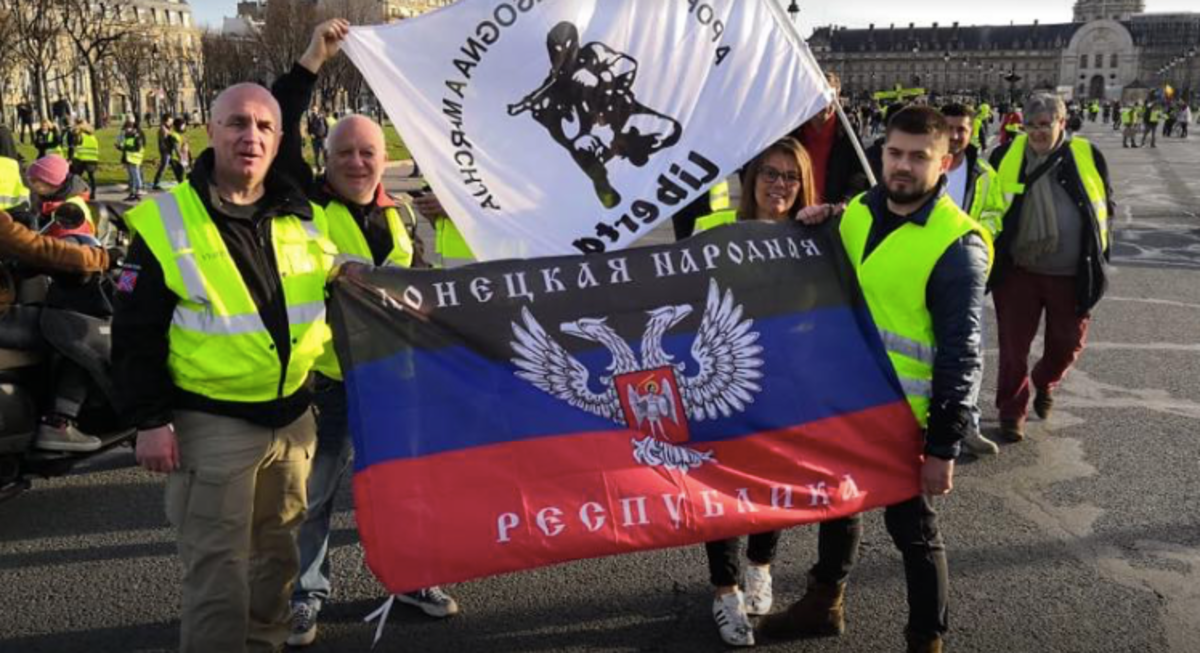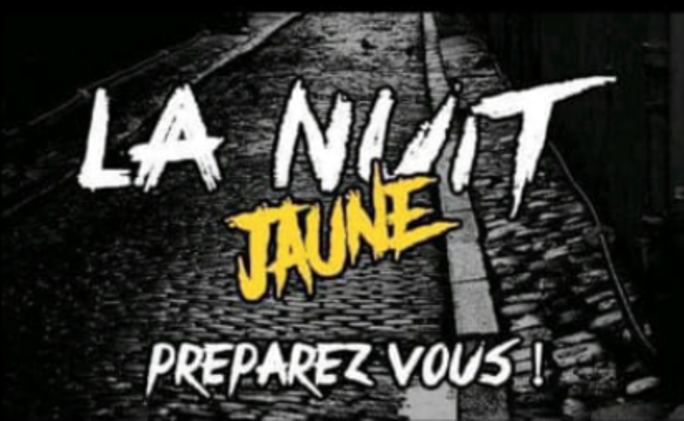This is the story of a president who says exactly the opposite of what his intelligence services are telling him. But this story is set not in North America but in the heart of old Europe, and not in the White House but in a room in the seat of French presidential power, the Élysée.
The story goes back to late morning on Thursday January 31st 2019. President Emmanuel Macron was hosting five journalists at the Élysée for an “informal discussion” over coffee. The French president was in relaxed mood, wearing a roll-neck sweater under a grey suit, as one can see from a photo published on the website of weekly magazine Le Point.
But though the president was relaxed and smiling, he was also biting once he started criticising the violence committed during the 'yellow vest' demonstrations. According to him, this violence was caused by “40,000 to 50,000 militants who want to destroy the [country's] institutions”. Paris-Match magazine, which was represented at the meeting, reported that: “In the face of the violence orchestrated by the extremes the [head of state] warned against the 'fachosphere' [editor's note, the community of extreme right activists online] and the 'gauchosphere' [editor's note, the community of far left activists online] who have overpopulated social media.”
Yet these comments were very surprising given that, in the same period, reports from the French intelligence services were being sent to the Élysée which, according to several sources, were saying exactly the opposite. In fact, the events of the eleventh weekend of 'yellow vest' protests that took place days before that informal chat at the Élysée rather supported the intelligence agencies' analysis of previous weeks. This was that the ultra-right had disengaged from the protests “in Paris and the provinces”. Indeed, the domestic intelligence agency, the Direction Générale de la Sécurité Intérieure (DGSI), apparently concluded one of its reports with the succinct observation: “The ultra-right scene is today almost non-existent in the [protest] marches.”

Enlargement : Illustration 1

In the protests of January 26th 2019 the intelligence services spotted just one member of the nationalist Parti Nationalist Français, one of the four ultra-right groups able to boast some local support across France. And a single member of the ultra-right Barjols collective, whose members had taken part in earlier 'yellow vest' protests, was spotted marching in a provincial protest, and peacefully.
The intelligence services give three reasons for this disengagement by right-wing extremists from the protests. First of all, it is because the ultra-right failed to take over the leadership of the social movement, secondly because some Islamophobic groups refused to join the yellow vests, on the grounds there were Muslims in their ranks, and finally because of a wave of arrests among ultra-right activists which calmed down the less committed ultra-nationalists, as Mediapart has reported.

It is true, however, that some on the extreme right did have a strategy of entryism in relation to the yellow vest movement. Some set up a group within the 'La Légion Jaune' ('The Yellow Legion'), others formed a group around the former soldier Victor Lenta. As Huffington Post has revealed, since mid-January 2019 Lenta has emerged as the organizer of security at the Paris demonstrations. A former paratrooper who wears a red beret above his yellow hi-vis vest, he was in the 3rd RPIMA parachute regiment based at Carcassonne in south-west France and is a former member of the Bloc Identitaire nationalist movement. Lenta became known in 2014 for his involvement with pro-Russians in the Donbass region of eastern Ukraine.
Other former soldiers were seen taking part in the the yellow vest security arrangements, but in his Huffington Post article journalist Pierre Tremblay says their presence was not part of a wider movement. Nor did it meet with the unanimous approval of all yellow vest protesters.
Mediapart understands that following the media coverage of Victor Lenta's involvement in the security details of the protests, the intelligence services observed that the former soldier himself had his own security protection. Contacted by Mediapart Lenta noted: “I was indeed threatened on the internet. It wasn't yellow vests, it was Antifas. But I don't have a bodyguard!”
In any case, the security agencies consider that the extremists still trying to infiltrate the yellow vest are only “a minority”. Even when such attempts at entryism were at their height in the first weeks of the movement, the agencies only counted “a few hundred individuals” coming from the ultra-right. This was already far-removed from the “40,000 to 50,000 individuals” spoken of by President Macron in January.
An intelligence official's alarm at the president's words
Could this discrepancy be because most of those referred to by the president came from the extreme-left rather than the right? It would appear not. “The ultra-left is involved in a limited way in a movement perceived as populist and reactionary,” noted a report from the DGSI. “From the start, the ultra-left was divided on the question of the yellow vests,” says an analyst from another intelligence agency. “We saw them in the marches but not much. They were there above all to take pictures.” After the violent scenes that accompanied the protests on December 1st and December 8th 2018, the DGSI noted that the involvement of hard-left activists was “still low”.
Since the start of this year the most conspicuous sign of the involvement of extreme factions from both the right and the left has been the clashes on the margins of the main protests between the two groups themselves. For example, on January 26th 2019 members of the ultra-right group the Zouaves de Paris – formerly the GUD – used iron bars to fight against activists from the anti-capitalist party the Nouveau Parti Anticapitalist on the fringes of the Gare de Lyon railway station in Paris.
Sources in different intelligence services have independently given the figure of “at the very most” 300 as the number of activists from the extreme left and right involved in the yellow vest movement at its high point in early December. Now there are apparently no more than a few dozen. In summary, the figures from the intelligence agencies do not back up the numbers that the president talked about in his chat with journalists in January.
Three weeks after President Macron's remarks, the director general of the DGSI, Nicolas Lerner, told Le Parisien newspaper that “at no time did the extremist groups succeed in taking over leadership of this movement”. On Thursday March 7th 2019 Mediapart asked the Élysée on what documents and factual basis Emmanuel Macron had relied to describe a movement as gangrenous and led by the two extremes. The president's press office did not respond.
The second issue on which Mediapart questioned the Élysée concerned Russia interference. According to Le Point, during Emmanuel Macron's “informal discussion” with journalists on January 31st the president defined the yellow vest movement as a “manipulation by the extremes, with the support of a foreign power. Putin's Russia, through Russia Today or Sputnik, came up in his comments. According to him, it is obvious that the radicalised yellow vests have been 'advised' from abroad.” In the words of the French president, their messages were passed on by “people who buy accounts, who troll”.
Back in early December 2018 The Times newspaper in London had claimed that Russia was behind hundreds of false accounts looking to boost the yellow vests' protests on social media. The French authorities set up an investigation by the defence and national security body the Secrétariat Général de la Défense et de la Sécurité Nationale (SGDSN), the results of which are not yet known.
But on December 16th 2018 the Journal du Dimanche newspaper published the comments of an official in the “intelligence services” stating that “the DGSE [editor's note, France's overseas intelligence agency] and the DGSI have not for the time being succeeded in gathering information about the direct implication of the Russian services in the spreading of false information or rumours of conspiracies in the context of the yellow vest movement”.
Statements recently made to Mediapart confirm this assessment: the DGSI and DGSE have still not found the slightest trace of Russian infiltration. Mediapart has even been told about the “alarm” of a senior official in French intelligence when he found out about Emmanuel Macron's comments. The Élysée did not respond to Mediapart's questions on this subject either.

“Inside the service one has the impression that this card [editor's note, of the influence of extremists from the left and right, or of Russian infiltration of the yellow vest movement] was produced to mask the fact that there was a problem in the country,” says the analyst cited earlier. “If it had really been the case it would have been spotted. The proof: from the first weeks we arrested activists from the ultra-left and the ultra-right and yet the violence never stopped.”
On the evening of Thursday March 7th, during a meeting in Gréoux-les-Bains in south-east France held as part of the great national debate created by the president in response to the yellow vest protests, Emmanuel Macron once again spoke of “some people” who “for several weeks” had “decided to infiltrate and as it were distort” the protestors by carrying out violence. We still do not know where the president is getting the information on which to base those claims. It would appear it is not coming from his own intelligence services.
-------------------------
If you have information of public interest you would like to pass on to Mediapart for investigation you can contact us at this email address: enquete@mediapart.fr. If you wish to send us documents for our scrutiny via our highly secure platform please go to https://www.frenchleaks.fr/ which is presented in both English and French.
------------------------------------------------------------------------
- The French version of this article can be found here.
English version by Michael Streeter


